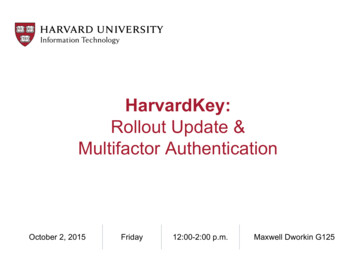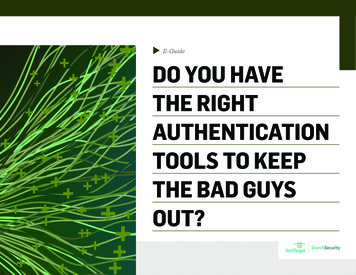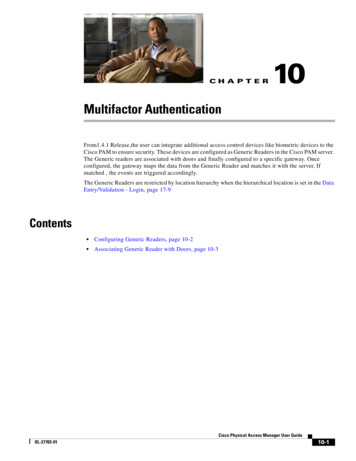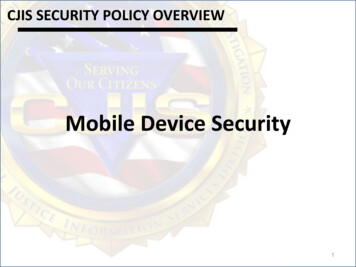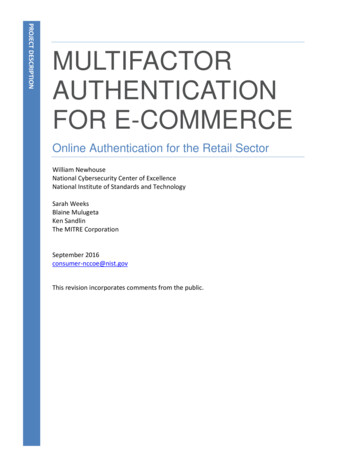
Transcription
PROJECT DESCRIPTIONMULTIFACTORAUTHENTICATIONFOR E-COMMERCEOnline Authentication for the Retail SectorWilliam NewhouseNational Cybersecurity Center of ExcellenceNational Institute of Standards and TechnologySarah WeeksBlaine MulugetaKen SandlinThe MITRE CorporationSeptember 2016consumer-nccoe@nist.govThis revision incorporates comments from the public.
The National Cybersecurity Center of Excellence (NCCoE) at the National Institute ofStandards and Technology (NIST) addresses businesses’ most pressing cybersecurityproblems with practical, standards-based solutions using commercially availabletechnologies. The NCCoE collaborates with industry, academic, and government expertsto build modular, open, end-to-end reference designs that are broadly applicable andrepeatable. To learn more about the NCCoE, visit http://nccoe.nist.gov. To learn moreabout NIST, visit http://www.nist.gov.This document describes a particular problem that is relevant across the consumerfacing/retail sector. NCCoE cybersecurity experts will address this challenge throughcollaboration with members of the consumer-facing/retail sector and vendors ofcybersecurity solutions. The resulting reference design will detail an approach that canbe used by consumer-facing/retail sector organizations.ABSTRACTAs greater security control mechanisms are implemented at the point of sale, retailers inthe U.S. may see a drastic increase in e-commerce fraud, similar to what has beenwidely observed in the United Kingdom and Europe following the rollout of Europay,MasterCard, and Visa (EMV) chip-and-PIN technology approximately ten years ago.Consumers, retailers, payment processors, banks, and card issuers are all impacted bythe security risks of e-commerce transactions. Retailers bear the cost for fraudulent,card-not-present (CNP) transactions, motivating them to reduce fraud in order to avoiddamage to reputation and eliminate potential revenue losses, which have beenestimated to be over 3 billion dollars.1 Successfully reducing e-commerce fraudrequires many, layered strategies, and includes an increased level of assurance inpurchaser or user identity. In collaboration with stakeholders in the retail and ecommerce ecosystem, the NCCoE has identified that implementing multifactorauthentication (MFA) for e-commerce transactions, tied to existing web analytics andcontextual risk calculation (by the retailer and/or by a federated identity provider), canincrease assurance in purchaser or user identity and thus help reduce the risk of falseonline identification and authentication fraud. The NCCoE understands that retail is avolume-reliant business and that consumers and retailers will adopt multifactorauthentication mechanisms as long as they do not unnecessarily encumber thepurchasing process or disrupt the user experience.Building on this collaboration with the business community and vendors ofcybersecurity solutions, the NCCoE will explore methods to effectively identify andauthenticate purchasers during e-commerce transactions and develop an examplesolution composed of open-source and commercially available components. This projectwill produce a NIST Cybersecurity Practice Guide—a publicly available description of thesolution and practical steps needed to implement practices that effectively identify andauthenticate purchasers during e-commerce transactions.Project Description Multifactor Authentication for e-Commerceii
KEYWORDSretail; multifactor; authentication; MFA; e-commerce; fraud; card-not-present; CNP; webanalytics; risk calculationDISCLAIMERCertain commercial entities, equipment, or materials may be identified in this documentin order to describe an experimental procedure or concept adequately. Suchidentification is not intended to imply recommendation or endorsement by NIST orNCCoE, nor is it intended to imply that the entities, materials, or equipment arenecessarily the best available for the purpose.Project Description Multifactor Authentication for e-Commerceiii
Table of Contents1. Executive Summary. 1Purpose . 1Scope . 2Assumptions . 2Background . 22. Scenarios . 2Scenario 1: Repeat customer, repeated context – MFA Not Activated . 2Scenario 2: Repeat customer, new context – MFA Activated . 3Scenario 3: Fraud perpetrator – MFA Activated. 33. High-Level Architecture . 4Component List . 4Desired Requirements . 54. Relevant Standards and Guidance . 55. Security Control Map . 6Appendix A – References . 7Project Description Multifactor Authentication for e-Commerceiv
1. EXECUTIVE SUMMARYPurposeThe purpose of this project is to help retailers implement stronger authenticationmechanisms (methods to ensure the card user is authorized to use the card by the cardowner) for e-commerce transactions in card-not-present (CNP) scenarios. While at thepresent time of this publication chip credit cards in the U.S. are being processed as chipand-signature rather than chip-and-PIN, the adoption of chip-and-PIN may beconsidered by some as an inevitability. As chip credit card usage increases, especiallywith PIN instead of signature at some point in the future, the ease with which fraudsterssuccessfully commit fraud in card-present scenarios will decrease. Thus, this projectaims to help prepare retailers in terms of proactively protecting themselves and theircustomers from the likely future increase in CNP e-commerce fraud in the U.S.To achieve this purpose, the National Cybersecurity Center of Excellence (NCCoE) willdevelop an example multifactor authentication solution composed of standards-basedcommercial and open-source products currently available in the marketplace. Theproject process includes identifying stakeholders and systems participating in the CNPtransactions, defining the interactions between the stakeholders and retailer systems,identifying mitigating security technologies, and ultimately providing an exampleimplementation.Multifactor authentication will also be central to a new National CybersecurityAwareness Campaign launched by the National Cyber Security Alliance designed to armconsumers with simple and actionable information to protect themselves in anincreasingly digital world. The National Cyber Security Alliance will partner with leadingtechnology firms like Google, Facebook, Dropbox, and Microsoft to make it easier formillions of users to secure their online accounts, and financial services companies suchas MasterCard, Visa, PayPal, and Venmo that are making transactions more secure.2Considering the anticipated rise of fraudulent activity due to stronger securitymechanisms for card-present transactions, retailers should invest in understanding andimplementing stronger authentication mechanisms for CNP purchases, while beingsensitive to the user experience.The publication of this project description is the beginning of a process that will identifyproject participants, cybersecurity vendors, and their relevant commercially available oropen-source hardware and software components. These components will be used in alaboratory environment where the project team will build open, standards-based,modular, end-to-end reference designs that will address the CNP authenticationproblem. The approach may include architectural definition, logical design, builddevelopment, test and evaluation, and security control mapping. The output of theprocess will be the publication of a multi-volume NIST Cybersecurity Practice Guide thatwill help consumer-facing and retail organizations implement multifactor authenticationfor e-commerce transactions.Project Description Multifactor Authentication for e-Commerce1
ScopeThe scope of this example solution includes the implementation of risk calculation, webanalytics, and common multifactor authentication mechanisms during e-commercetransactions for a repeat customer (RC) of a simulated retailer website. The projectscope may or may not include identity federation. For the purposes of this project, guestcheckout purchasing flows, blockchain and distributed ledger technologies,micropayments, and security challenges specific to mobile payments and mobileshopping are out of scope but may be considered for future work for the NCCoE in theconsumer-facing/retail space.AssumptionsThis example solution of multifactor authentication for e-commerce transactionsprovides numerous security benefits including increased confidence in user identity andreduced risk. The NCCoE understands that a retail business would weigh the cost ofinvestment in a multifactor authentication solution with its potential benefits, whichinclude protection of reputation and trust from the consumer, as well as reduced fraudlosses.The security of existing systems and networks is out of scope for this project. A keyassumption is that all potential adopters of this project or any of its components alreadyhave in place some degree of system and network security, as well as many, layered ecommerce fraud reduction measures. Therefore, we intend to focus on the effort ofcomplementing existing system and network security and e-commerce fraud reductionstrategies with risk calculation, web analytics, and multifactor authentication.BackgroundThe NCCoE, working with retail organizations and other e-commerce paymentstakeholders, including information sharing and analysis centers (ISACs) and the RetailCyber Intelligence Sharing Center (R-CISC), has identified the potential need andbenefits of a multifactor authentication for e-commerce solution. The need arises fromthe recognition that malicious actors are likely increasingly motivated to exploit securityvulnerabilities in CNP retail transactions in response to the adoption of EMV chip creditcards in the U.S.The NCCoE also held a workshop to identify key issues that affect multifactorauthentication for e-commerce. The conversations held and insight derived from thatworkshop have informed the direction of this project and this project description.2. SCENARIOSScenario 1: Repeat customer, repeated context – MFA Not ActivatedWhile getting his child ready for bed, the RC of an online retailer finds the supply ofdisposable diapers is low. The RC logs into the online retailer's website to orderProject Description Multifactor Authentication for e-Commerce2
disposable diapers. He authenticates with a user ID and password and finds the diapersin the favorites section. In seconds, the RC places the same order for diapers that he hasplaced in the past, and is not prompted for any additional authentication.In the background, automated risk and web analytics on the retailer’s system arecomparing the RC’s current behavior and the context of his website access to storeddata. The online retailer grades this purchase as low risk because of the nature of theproduct, a known internet protocol (IP) address associated with the customer, typicalgeolocation, and consistency with past patterns of online purchases. In this scenario, thestepped up additional authentication was not activated.Scenario 2: Repeat customer, new context – MFA ActivatedWhile on travel for business across the country from her residence, a RC of an onlineretailer remembers that this day would be the deadline to buy a gift online for a friend’sbirthday. She opens the laptop she usually uses exclusively for work and navigates tothe retailer’s website. The RC authenticates with a user ID and password and browsesseveral categories of expensive items that she usually does not browse. After some timebrowsing, the customer finds a product to purchase and puts it in her virtual shoppingcart. She then follows the prompts to choose shipping and stored payment methods.After entering these choices, the user is prompted with a message stating that theretailer requests she enter an additional authenticator3 before completing thetransaction. The user completes the multifactor authentication process and completesthe transaction.In the background, automated risk and web analytics on the retailer’s system arecomparing the RC’s current behavior and the context of her website access to storeddata. The online retailer grades this purchase as high risk because of the nature of theproduct, an unknown IP address associated with the customer, atypical geolocation, anddeviance from past patterns of online purchases. In this scenario, the stepped upadditional authentication was activated.Scenario 3: Fraud perpetrator – MFA ActivatedAfter illegally receiving the credentials of a legitimate RC of an online retailer, a fraudperpetrator (FP) in a country different from the RC navigates to the retailer’s websitewith the intention of committing e-commerce fraud and receiving goods paid for by theRC. The FP does not browse but goes straight to an expensive electronic item, adds theitem to his shopping cart, and begins the checkout process. During checkout, the FPchooses stored payment information, but edits the shipping address to one notpreviously associated with the RC. After entering these choices, the FP is prompted witha message requesting that he enter a multifactor authentication ID as an additional stepbefore completing the transaction. The FP attempts to spoof the ID a number of timesbefore another message appears indicating that the transaction has been terminatedand the account has been locked.Project Description Multifactor Authentication for e-Commerce3
In the background, automated risk and web analytics on the retailer’s system arecomparing the FP’s current behavior and the context of her website access to storeddata. The user’s device, behavior, IP address, geolocation, and shopping choices do notalign sufficiently per the retailer’s risk threshold and pose a relatively high fraud risk, sothe FP is prompted for additional authentication. Because the retailer has implementeda limit to additional multifactor authentication attempts, after a few attempts the useraccount is locked until the retailer’s fraud detection team can contact the accountowner. In this scenario, the stepped up additional authentication was activated.3. HIGH-LEVEL ARCHITECTUREFigure 1: High-level ArchitectureComponent ListA multifactor authentication solution for e-commerce transactions includes but is notlimited to the following components: Online/e-commerce shopping cart and payment system (in-house or outsourced) Multifactor authentication mechanisms (types of which to be determined) Risk calculation platform/engineProject Description Multifactor Authentication for e-Commerce4
Web analytics engine Logging of risk calculation and web analytics data Data storage for risk calculation and web analytics data Identity federation mechanism (optional)Desired Requirements Authentication mechanisms that meet business security and regulatoryrequirements Automated web analytics including monitoring of user behavior and contextualdetails Automated logging of web analytics and risk calculation data Automated data storage of web analytics and risk calculation data Ability to establish and enforce risk decisions including performing riskcalculations Automated alerting of suspected fraudulent activity Ease of use for the consumer, no substantial increase in friction during the ecommerce transaction Identity federation (optional)4. RELEVANT STANDARDS AND GUIDANCE ISO/IEC 27001, Information Technology – Security Techniques – InformationSecurity Management Systemshttp://www.iso.org/iso/home/search.htm?qt 27001&sort rel&type simple&published on ISO/IEC 29115, Information Technology – Security Techniques – Entityauthentication assurance frameworkhttp://www.iso.org/iso/catalogue detail.htm?csnumber 45138 ISO/IEC 29146, Information Technology – Security techniques – A framework foraccess management, ed1:v1:en NIST Cybersecurity Framework - Standards, guidelines, and best practices topromote the protection of critical rk.cfm NIST SP 800-53, Recommended Security Controls for Federal s/drafts/800-53-rev4/sp800-53-rev4-ipd.pdf NIST SP 800-63-2, Electronic Authentication 0-63-1/SP-800-63-1.pdfProject Description Multifactor Authentication for e-Commerce5
NIST SP 800-73-4, Interfaces for Personal Identity Verification (3 ications/NIST.SP.800-73-4.pdf Payment Card Industry (PCI) Data Security Standard, Requirements and SecurityAssessment Procedures, Version 3.2, April 2016, PCI Security Standards ents/PCI DSS v3-2.pdf5. SECURITY CONTROL MAPTable 1 maps the characteristics of the applicable standards and best practicesdescribed in the Framework for Improving Critical Infrastructure Cybersecurity (CSF),and other NIST activities. The solution characteristics offered in the table are the onesexpected to be explored in this project. This mapping exercise, which is likely to expandas the project progresses, is meant to demonstrate the real-world applicability ofstandards and best anismsNIST CSFInformative ReferencesCategoryPR.AC-1 NIST SP 800-53 Rev. 4 AC-1, IA Family; AC-17, AC-19,AC-20; AC-2, AC-3, AC- 5, AC-6, AC-16PR.AC-3 ISO/IEC 27001:2013 A.9.2.1, A.9.2.2, A.9.2.4, A.9.3.1,A.9.4.2, A.9.4.3; A.6.2.2, A.13.1.1, A.13.2.1; A.6.1.2,PR.AC-4 A.9.1.2, A.9.2.3, A.9.4.1, A.9.4.4Automated webanalyticsDE.AE-1DE.AE-2DE.AE-3Automated loggingPR.PT-1NIST SP 800-53 Rev. 4 AC-4, CA-3, CM-2, SI-4; AU-6,CA-7, IR-4, IR 5, IR-8, SI-4;ISO/IEC 27001:2013 A.16.1.1, A.16.1.4NIST SP 800-53 Rev. 4 AU Family, IR-5, IR-6ISO/IEC27001:2013 A.12.4.1, A.12.4.2, A.12.4.3,A.12.4.4, A.12.7.1Automated datastoragePR.DS-1NIST SP 800-53 Rev. 4 SC-28; CM-8, MP-6, PE-16PR.DS-3ISO/IEC27001:2013 7.1.1, 7.1.2, 9.1.6, 9.2.6, 9.2.7,10.7.1, 10.7.2, 10.7.3Ability to establishand enforce riskdecisionsID.RA-3NIST SP 800-53 Rev. 4 RA-2, RA-3, PM-9, PM-11, PM12, PM-16, SA-14, SI-5ID.RA-4ID.MSTable 1: Security Control MapProject Description Multifactor Authentication for e-Commerce6
APPENDIX A – REFERENCES[1]Payment Card Fraud Management: Essential Tools for U.S. Card Issuers, JulieConroy, Aite Group, April 2, 2015, gement-essential-tools-us-card-issuers[2]Fact Sheet: Cybersecurity National Action Plan, Office of the Press Secretary, TheWhite House, February 9, 2016, 3]Draft NIST Special Publication 800-63-3, Digital Authentication Guideline: PublicPreview, Paul A. Grassi and James L. Fenton, National Institute of Standards andTechnology, U.S. e-commerce grows 14.6% in 2015, Stefany Zaroban, Internet RetailerMagazine, February 17, 2016, mmerce-grows-146-2015[5]NIST Framework for Improving Critical Infrastructure Cybersecurity, Version 1,February 12, 2014, urityframework-021214.pdf[6]Bring on Cyber Monday: E-Commerce Merchants and Fraud, RSA Monthly OnlineFraud Report – October 2014, ine-fraud-report-102014.pdf[7]E-Commerce Fraud Trends 2014: Securing the Online Shopping Cart, RSA MonthlyOnline Fraud Report – July 2014, ine-fraud-report-0714.pdf[8]E-Commerce Transactions – A New Roadmap for Authentication in Europe,Christoph Baert, Paul Baker, and Cathy Mulrow-Peattie, MasterCard rope.pdf[9]Preparing for Chip-and-PIN Cards in the United States, Mark Scott, New York Times,December 2, 2014, -for-chipand-pin-cards-in-the-united-states/? r 1[10]Card-Not-Present Fraud: A Primer on Trends and Authentication Processes, ASmart Card Alliance Payments Council White Paper, Smart Card Alliance PaymentsCouncil, February 2014, WP-012414.pdfProject Description Multifactor Authentication for e-Commerce7
[11]Card-Not-Present Fraud Working Committee White Paper: Near-Term Solutions toAddress the Growing Threat of Card-Not-Present Fraud, Version 1.0, EMVMigration Forum: Card-Not-Present Fraud Working Committee, April Information technology – Security techniques – Information security managementsystems – Requirements, International Organization for Standardization (ISO),http://www.iso.org/iso/catalogue detail?csnumber 54534Project Description Multifactor Authentication for e-Commerce8
modular, end-to-end reference designs that will address the CNP authentication problem. The approach may include architectural definition, logical design, build development, test and evaluation, and security control mapping. The output of the process will be the publication of a multi-volume NIST Cybersecurity Practice Guide that
